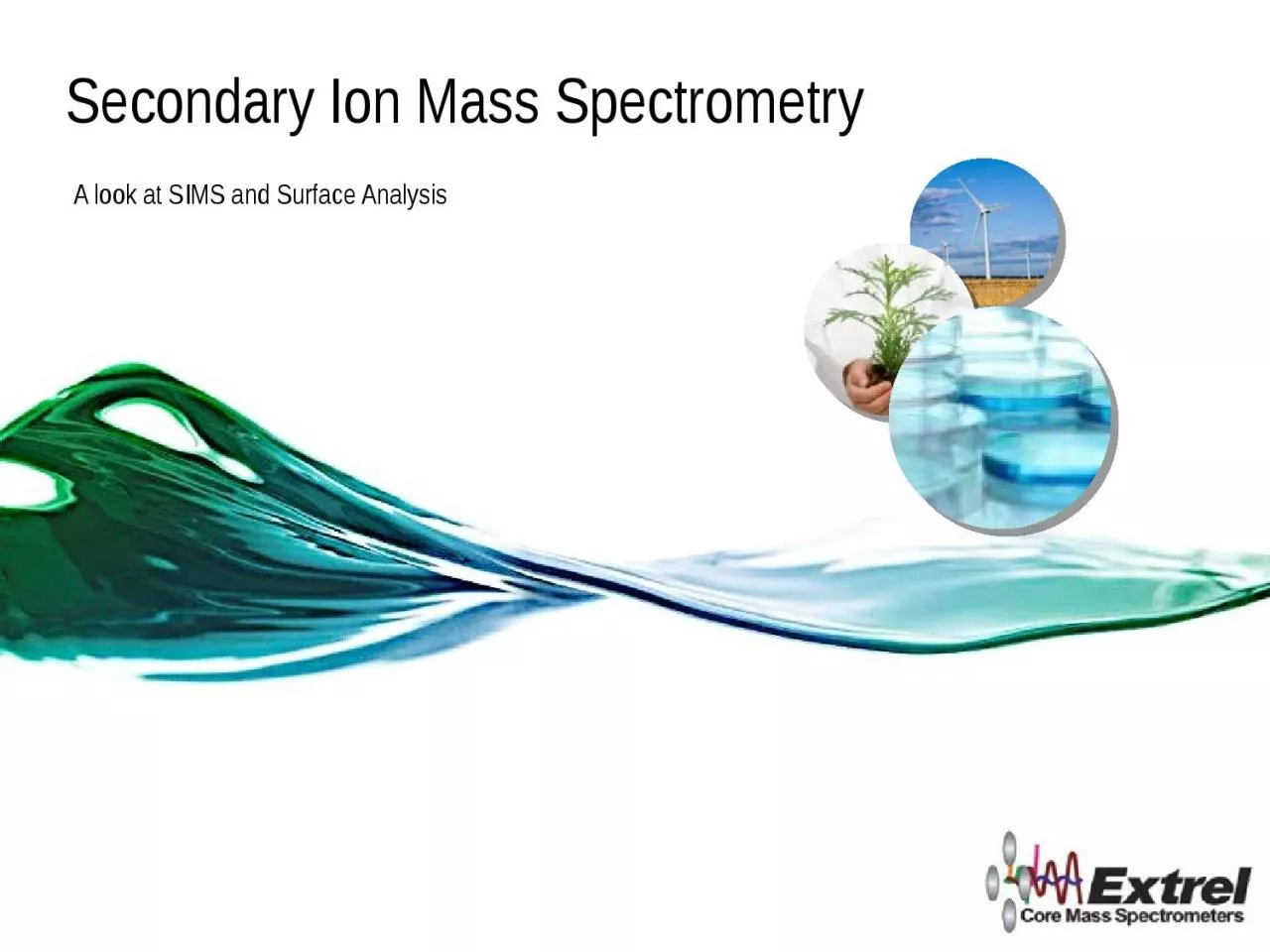

A look at SIMS and Surface Analysis Secondary Ion Mass Spectrometry What are Secondary Ions Ions created from the interaction between a surface and an ion beam the primary ions Require high vacuum 10 ID: 1039662
Download Presentation The PPT/PDF document "Secondary Ion Mass Spectrometry" is the property of its rightful owner. Permission is granted to download and print the materials on this web site for personal, non-commercial use only, and to display it on your personal computer provided you do not modify the materials and that you retain all copyright notices contained in the materials. By downloading content from our website, you accept the terms of this agreement.
1. Secondary Ion Mass SpectrometryA look at SIMS and Surface Analysis
2. Secondary Ion Mass SpectrometryWhat are Secondary Ions?Ions created from the interaction between a surface and an ion beam (the primary ions)Require high vacuum (≤10-6 torr) in order to minimize ion-ion interactionsAnalyzed using a mass spectrometerStudies are used to gather information about the surface being analyzed and can fall in to two categoriesDynamic SIMS – used for bulk analysis using a DC ion beam and a QMSStatic SIMS – used for atomic monolayer analysis using a pulsed laser and a TOF
3. Target of SIMS StudiesTypically flat surfaces or rods CuBeAlRapidly growing interest in studying 3DOrganometallics and films from metal or semiconductor surfacesThese trends demand that the Mass Spectrometer haveBetter ResolutionHigher SensitivityMass Range Options
4. MAX-CS Probes are the Proven SolutionPowerful research grade instruments. Best performance of flange mounted systemsHeart of Extrel’s VeraSpec Mass Spectrometer SystemsWidest array of options of any of our systems Mass Ranges50, 120, 500, 1000, 4000, 16000 maximum masses Based off of quad size + RF frequencyTwo Quadrupole SizesMS/MS optionMultiple ionization sourcesConical aperture on the Ionizer can be located close to the substrate to ionize the desorbed neutral compoundsEnergy Filter Ionizer to differentiate between secondary ions and ionized neutrals in the chamberHas fine control of the ionizer to perform “soft” ionization to retain the molecular ion without fragmentationSIMS Analysis Features of MAX Probe Systems
5. MAX-LT Probes Provide a Quality solution at an Affordable CostResearch grade performance at an affordable price. 500 and 1000 amu mass rangesPositive and negative ion detectionTypical applicationsThermal Programmed Desorption (TPD)Plasma and Chemical Vapor Deposition (CVD) Analysis UHV Residual Gas Analysis.
6. SIMS Analysis: Energy Filter IonizerHigh Energy ions (1 keV – 100 keV) Not easily analyzed by QMSShould be blocked from entering the analyzerCenter stop of the energy filter Keeps neutrals from entering the analyzer Blocks line-of-sight.Excellent Energy FilteringCylindrical lens of energy filter Bandpass lensesabove and below the cylinder Center stopCone aperture Allows close placement to the target surfaceGreater sensitivity to the sputtered plumeOn-axis energy filter Fine energy scan < 0.6 eV FWHM (full width at half maximum) resolution
7. SimION Modeling of the Energy Filter Ionizer
8. CuBe ExperimentThe SIMS spectra for the CuBe alloy were collected using: MAX-120 with a tandem ionizer/energy analyzer 19 mm Quadrupole & 2.1 MHz QCBase pressure: 1.6x10-9 TorrPrimary ions: 2 keV Ar+ ionsIncident angle (angle between the sample surface normal and the axis of the ion gun): ~ 80°Collection angle (the angle between the sample surface normal and the axis of the SIMS probe): ~ 10° All of the SIMS spectra were acquired after the sample had been sputtered with a much higher current of the Ar+ ions. SIMS spectra are characteristic of the unoxidized sample surfaceIons of different kinetic energy were selected by the energy analyzer Ions coming out of the energy analyzer were then mass analyzed by the quadrupole mass filter The pass energy of the energy analyzer is set by the voltage applied to the main cylindrical lens of the energy analyzer and the kinetic energy of the selected secondary ions is close to the pass energy
9. SIMS Spectra: 4.8 eV Pass EnergyCopper Beryllium surface analysis
10. SIMS Spectra: 13.5 eV Pass EnergyCopper Beryllium surface analysis
11. SIMS Spectra: 20.2 eV Pass EnergyCopper Beryllium surface analysis
12. SIMS Spectra: 30.0 eV Pass EnergyCopper Beryllium surface analysis
13. SIMS Data SummaryThe Be+ and Cu+ ion intensities measured at different pass energies allowing for precise measurement of each compoundPass Energy (eV)Beryllium Intensity (m/z 9; kCPS)Copper Intensity (m/z 63; kCPS)4.8360<213.51205420.21006730.09236
14. Solutions to SIMS AnalysisCharacteristics of the secondary ions:Absolute ion intensities depend on the pass energyThe Be-to-Cu ion intensity ratio changes with the pass energyThe Be+ and Cu+ ions from the bombarded CuBe alloy surface have very different ion energy distributionsCu+ ion intensity peaks around 20 eV Be+ ions achieves its maximum intensity at a much lower kinetic energy
15. For More Information:Please visit us at Booth XXXOr on our website at Extrel.com